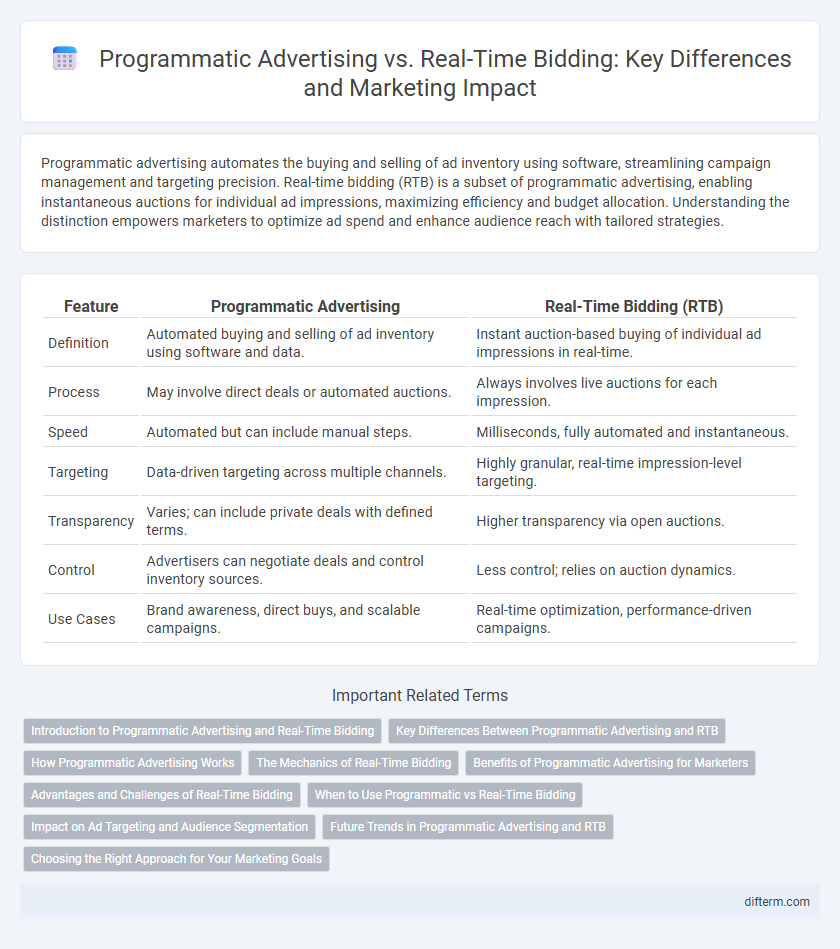Programmatic advertising automates the buying and selling of ad inventory using software, streamlining campaign management and targeting precision. Real-time bidding (RTB) is a subset of programmatic advertising, enabling instantaneous auctions for individual ad impressions, maximizing efficiency and budget allocation. Understanding the distinction empowers marketers to optimize ad spend and enhance audience reach with tailored strategies.
Table of Comparison
| Feature | Programmatic Advertising | Real-Time Bidding (RTB) |
|---|---|---|
| Definition | Automated buying and selling of ad inventory using software and data. | Instant auction-based buying of individual ad impressions in real-time. |
| Process | May involve direct deals or automated auctions. | Always involves live auctions for each impression. |
| Speed | Automated but can include manual steps. | Milliseconds, fully automated and instantaneous. |
| Targeting | Data-driven targeting across multiple channels. | Highly granular, real-time impression-level targeting. |
| Transparency | Varies; can include private deals with defined terms. | Higher transparency via open auctions. |
| Control | Advertisers can negotiate deals and control inventory sources. | Less control; relies on auction dynamics. |
| Use Cases | Brand awareness, direct buys, and scalable campaigns. | Real-time optimization, performance-driven campaigns. |
Introduction to Programmatic Advertising and Real-Time Bidding
Programmatic advertising automates the buying and selling of digital ad space using software to target specific audiences efficiently. Real-time bidding (RTB) is a core component of programmatic advertising, enabling advertisers to bid on individual impressions in milliseconds through an automated auction process. This dynamic approach maximizes ad relevance and budget optimization by delivering ads to the right users at the right time.
Key Differences Between Programmatic Advertising and RTB
Programmatic advertising encompasses the automated process of buying digital ad space through software, while real-time bidding (RTB) is a specific auction-based method within programmatic that allows advertisers to bid on individual impressions in real time. Programmatic offers broader purchasing options including direct and private marketplace deals, whereas RTB strictly operates through open auctions for immediate ad placements. The key difference lies in RTB's emphasis on instantaneous bidding and impression-level targeting, contrasting with programmatic advertising's overall strategic and multi-channel approach.
How Programmatic Advertising Works
Programmatic advertising automates the buying and selling of digital ad space using algorithms and data-driven platforms to target specific audiences efficiently. It leverages real-time consumer data and machine learning to optimize ad placements across multiple channels, maximizing campaign performance and ROI. This process integrates demand-side platforms (DSPs), supply-side platforms (SSPs), and ad exchanges to facilitate seamless transactions and audience reach.
The Mechanics of Real-Time Bidding
Real-Time Bidding (RTB) operates through automated auction processes where ad impressions are bought and sold in milliseconds, enabling advertisers to bid on specific audiences in real time. The process involves supply-side platforms (SSPs) sending bid requests, which demand-side platforms (DSPs) analyze to place bids based on targeting criteria and budget constraints. RTB's efficiency lies in its ability to optimize ad spend by dynamically matching impressions to advertisers' precise audience segments within programmatic advertising ecosystems.
Benefits of Programmatic Advertising for Marketers
Programmatic advertising streamlines campaign management by automating the buying process, allowing marketers to target specific audiences with precision across multiple channels. It leverages data-driven algorithms to optimize ad placement in real-time, increasing efficiency and reducing wasted ad spend. This approach enhances transparency and scalability, making it easier for marketers to measure performance and adjust strategies dynamically.
Advantages and Challenges of Real-Time Bidding
Real-time bidding (RTB) offers precise targeting and cost efficiency by enabling advertisers to bid for individual ad impressions through automated auctions, maximizing budget allocation based on real-time data. Advantages include increased transparency, improved audience segmentation, and dynamic price adjustments that enhance campaign performance. Challenges involve complex technology integration, potential latency issues, and concerns over ad fraud and brand safety that require sophisticated monitoring solutions.
When to Use Programmatic vs Real-Time Bidding
Programmatic advertising offers a streamlined solution for broad audience targeting across multiple channels, ideal for brand awareness campaigns with scalable budgets. Real-Time Bidding (RTB) excels in highly specific, auction-based environments where advertisers seek granular control over individual ad impressions and performance optimization. Choose programmatic for efficient media buying at scale, and opt for RTB when precise targeting and dynamic bidding strategies maximize return on ad spend.
Impact on Ad Targeting and Audience Segmentation
Programmatic advertising leverages advanced algorithms and data analytics to automate media buying, enabling precise audience segmentation based on demographics, behavior, and interests. Real-time bidding (RTB), a subset of programmatic, facilitates instantaneous auctions for individual ad impressions, enhancing targeting accuracy by delivering ads to users at the optimal moment. Both technologies improve campaign efficiency and ROI by dynamically optimizing ad placements and personalizing content for specific audience segments.
Future Trends in Programmatic Advertising and RTB
Future trends in programmatic advertising and real-time bidding (RTB) emphasize increased adoption of artificial intelligence and machine learning to enhance targeting precision and campaign efficiency. The integration of first-party data and privacy-compliant solutions driven by regulations like GDPR and CCPA is set to reshape audience segmentation and bidding strategies. Advanced automation and predictive analytics will empower marketers to optimize ad spend and improve return on investment in a rapidly evolving digital landscape.
Choosing the Right Approach for Your Marketing Goals
Programmatic advertising automates the purchase of ad space through advanced algorithms, offering broader targeting options and enhanced campaign efficiency. Real-time bidding (RTB) is a subset of programmatic advertising where ad impressions are auctioned in milliseconds, ideal for highly specific audience targeting and budget control. Marketers should evaluate their goals, budget, and scale preferences to determine whether the comprehensive reach of programmatic advertising or the precision of RTB aligns better with their campaign objectives.
Programmatic Advertising vs Real-Time Bidding Infographic

 difterm.com
difterm.com